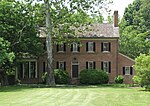The Battle of Spotsylvania Court House, sometimes more simply referred to as the Battle of Spotsylvania (or the 19th-century spelling Spottsylvania), was the second major battle in Lt. Gen. Ulysses S. Grant and Maj. Gen. George G. Meade's 1864 Overland Campaign of the American Civil War. Following the bloody but inconclusive Battle of the Wilderness, Grant's army disengaged from Confederate General Robert E. Lee's army and moved to the southeast, attempting to lure Lee into battle under more favorable conditions. Elements of Lee's army beat the Union army to the critical crossroads of the Spotsylvania Court House in Spotsylvania County, Virginia, and began entrenching. Fighting occurred on and off from May 8 through May 21, 1864, as Grant tried various schemes to break the Confederate line. In the end, the battle was tactically inconclusive, but both sides declared victory. The Confederacy declared victory because they were able to hold their defenses. The United States declared victory because the Federal offensive continued and Lee's army suffered losses that could not be replaced. With almost 32,000 casualties on both sides, Spotsylvania was the costliest battle of the campaign.
On May 8, Union Maj. Gens. Gouverneur K. Warren and John Sedgwick unsuccessfully attempted to dislodge the Confederates under Maj. Gen. Richard H. Anderson from Laurel Hill, a position that was blocking them from Spotsylvania Court House. On May 10, Grant ordered attacks across the Confederate line of earthworks, which by now extended over 4 miles (6.4 km), including a prominent salient known as the Mule Shoe. Although the Union troops failed again at Laurel Hill, an innovative assault attempt by Col. Emory Upton against the Mule Shoe showed promise.
Grant used Upton's assault technique on a much larger scale on May 12 when he ordered the 15,000 men of Maj. Gen. Winfield Scott Hancock's corps to assault the Mule Shoe. Hancock was initially successful, but the Confederate leadership rallied and repulsed his incursion. Attacks by Maj. Gen. Horatio Wright on the western edge of the Mule Shoe, which became known as the "Bloody Angle", involved almost 24 hours of desperate hand-to-hand fighting, some of the most intense of the Civil War. Supporting attacks by Warren and by Maj. Gen. Ambrose Burnside were unsuccessful.
Grant repositioned his lines in another attempt to engage Lee under more favorable conditions and launched a final attack by Hancock on May 18, which made no progress. A reconnaissance in force by Confederate Lt. Gen. Richard S. Ewell at Harris farm on May 19 was a costly and pointless failure. On May 21, Grant disengaged from the Confederate Army and started southeast on another maneuver to turn Lee's right flank, as the Overland Campaign continued and led to the Battle of North Anna.










